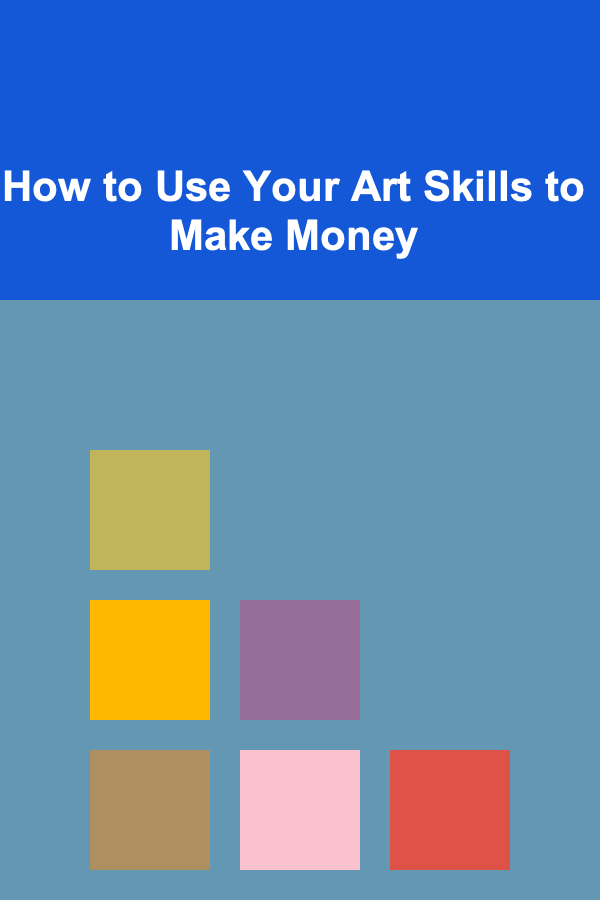
How to Use Your Art Skills to Make Money
ebook include PDF & Audio bundle (Micro Guide)
$12.99$5.99
Limited Time Offer! Order within the next:

Art has always been a form of expression, creativity, and passion. Whether you're painting, drawing, sculpting, or working in digital mediums, your artistic abilities can open up a multitude of opportunities to earn money. In today's world, where there are countless avenues to share and sell your work, it's more feasible than ever to turn your art into a sustainable source of income. This article explores the various ways you can use your art skills to generate money, from freelance work to starting your own business.
The Growing Demand for Art
In recent years, the demand for art has seen an increase, with people becoming more aware of the impact and importance of supporting artists. The growing interest in unique, custom-made items, as opposed to mass-produced products, has significantly impacted the market for art. In addition, the rise of digital art, as well as the expanding online market, has opened up new platforms for artists to showcase and sell their work. With so many different ways to monetize art, it's essential for artists to recognize and take advantage of the various opportunities available.
Selling Your Art Online
One of the most effective and convenient ways to sell your art is through online platforms. With millions of people browsing the internet every day, there's a massive potential customer base for your work. Here are some popular online platforms where you can sell your art:
2.1 Etsy
Etsy is a go-to platform for many artists who want to sell their artwork. It's especially popular for handmade, vintage, and craft items, making it a perfect place for artists to reach an audience that values originality and unique designs. Etsy allows you to set up your own store, list products, and connect with buyers. You can sell paintings, illustrations, prints, and even handmade art supplies. Etsy charges listing fees and takes a small commission from each sale, but it provides a massive audience for your work.
2.2 Society6
Society6 is an online platform that allows artists to sell their designs and artwork on a variety of products. From wall art to home decor, clothing, and accessories, your designs can be turned into a wide range of physical products. Once you upload your artwork, Society6 handles the production, shipping, and customer service, allowing you to focus solely on creating. It's a great way for artists to monetize their work without worrying about logistics or overhead costs.
2.3 Redbubble
Similar to Society6, Redbubble is a print-on-demand service that lets artists upload their designs and sell them on various products. Redbubble offers a wide range of customizable products, including t-shirts, phone cases, mugs, stickers, and more. Artists set their own prices for each item, and Redbubble handles all the manufacturing and shipping. This is an excellent option if you want to reach a large, global audience without the hassle of dealing with the production process.
2.4 Saatchi Art
Saatchi Art is a high-end online gallery that connects artists with collectors. If you create original artwork, Saatchi Art allows you to showcase and sell your paintings, sculptures, and photography to a global audience of art collectors and enthusiasts. Saatchi Art handles the marketing, logistics, and payment processing, making it an excellent choice for those who want to target serious art buyers.
2.5 Your Own Website
While third-party platforms are convenient, having your own website provides greater control over how you present and sell your work. Setting up an online store on your website allows you to keep all the profits and create a more personalized shopping experience for your customers. Platforms like Shopify, Squarespace, and Wix offer user-friendly tools to set up an e-commerce site. With your own website, you can also build your brand and grow a loyal customer base.
Freelancing and Commissioned Work
Freelancing as an artist is another popular way to monetize your art skills. There are numerous websites and platforms where you can find freelance gigs and commissions. Many businesses, individuals, and organizations need custom artwork for a variety of purposes, such as marketing, branding, book covers, illustrations, and more. Here are some of the best platforms for finding freelance art opportunities:
3.1 Upwork
Upwork is a global freelance marketplace that connects clients with freelancers in various industries. As an artist, you can find a range of art-related jobs, from creating illustrations and graphics to designing logos or even working on animation projects. Upwork allows you to create a profile, showcase your portfolio, and apply for jobs that match your skill set. You can set your hourly rate or project price, and the platform takes a small commission on your earnings.
3.2 Fiverr
Fiverr is another popular platform for freelancers. On Fiverr, you can create listings (called "gigs") for specific art services, such as custom illustrations, digital paintings, logo design, or portraiture. Clients browse the platform for services they need and hire freelancers based on the skills and prices they see. Fiverr is excellent for artists who want to offer specific services at set prices and can handle multiple small projects.
3.3 99designs
If you're particularly skilled in graphic design, 99designs is a great platform for finding design work. Clients post design contests or offer direct freelance opportunities for logo designs, branding, website design, and more. As a designer, you can submit your work for contests or apply for open jobs. 99designs has a competitive community, so it's essential to create a strong portfolio to stand out.
3.4 Behance
Behance, owned by Adobe, is an online portfolio platform for creative professionals. While it's not a direct freelance marketplace, many businesses and individuals use Behance to discover talented artists. By showcasing your work on Behance, you can attract potential clients who are looking to commission artwork or hire you for freelance projects. Behance also allows you to connect with other creatives and join a community of professionals in your field.
3.5 Personal Networking and Word of Mouth
In addition to online platforms, personal networking can also help you find freelance work. Attend art shows, network with other artists, and participate in local events to get your name out there. Word of mouth is a powerful tool for artists, as clients who have been happy with your work may refer you to others. Building strong relationships within your community and industry can lead to ongoing opportunities for commissioned work.
Teaching and Tutorials
If you have a strong understanding of art and a passion for teaching, offering art classes or creating online tutorials is a great way to monetize your skills. Many people want to learn how to draw, paint, or develop their creative skills but lack the resources or knowledge to get started. By teaching others, you not only share your passion but also create a source of income. Here are some options for teaching and sharing your expertise:
4.1 Create Online Art Courses
Platforms like Udemy, Skillshare, and Teachable allow artists to create and sell their own online courses. If you're skilled in a particular medium or technique, you can develop a course that teaches others how to master it. Once your course is created, you can earn passive income every time someone signs up.
4.2 Offer Private Art Lessons
Private art lessons, either in-person or online, are another way to make money. Many people are willing to pay for one-on-one lessons with an experienced artist to help improve their skills. You can set your rates based on your experience and the length of the lessons. Platforms like Zoom or Skype make it easy to teach art remotely, so you can offer lessons to students anywhere in the world.
4.3 YouTube Tutorials
Creating free art tutorials on YouTube is a great way to build a following and potentially monetize your content. Once you have a solid base of subscribers, you can make money through YouTube's ad revenue system, sponsorships, and even by offering your own products or services. Many successful artists use YouTube as a platform to not only share their knowledge but also promote their art business.
Art Licensing and Merchandising
If you're not interested in selling your art directly but still want to make money from it, licensing and merchandising are great alternatives. Licensing your art allows companies or individuals to use your artwork on products, packaging, advertising, and more. In return, you receive royalties or a licensing fee.
5.1 Art Licensing Agencies
There are numerous art licensing agencies that help artists license their artwork to companies. These agencies typically work with large brands or manufacturers, and in exchange for representing your work, they take a percentage of the licensing fee. Some agencies specialize in specific types of art, such as illustrations or photography, while others cater to various styles and mediums.
5.2 Self-Licensing
Alternatively, you can handle your own licensing directly by reaching out to companies and brands. Many companies are looking for fresh artwork to feature on their products, whether it's a clothing line, home décor, or stationery. By negotiating licensing agreements yourself, you can keep a larger percentage of the earnings.
Conclusion
Monetizing your art skills is not only possible but also increasingly accessible in today's interconnected world. Whether you choose to sell your work online, take on freelance projects, offer art classes, or license your designs, there are endless opportunities to turn your passion into a sustainable income source. By diversifying your income streams and leveraging various platforms, you can create a steady flow of revenue while continuing to focus on what you love---making art.
The key to success is consistency, patience, and continuously honing your craft. As long as you stay dedicated and remain open to new opportunities, your art can become not just a form of self-expression but a profitable and fulfilling career.

How to Host a Family Puzzle and Game Night Tournament
Read More
How to Organize a Bedroom Using Bed Frames with Storage
Read More
How to Sell Homemade Baked Goods and Start a Bakery Business from Home
Read More
Making Money from Deep Learning Apps and AI Solutions
Read More
Practical Ways to Cut Costs on Laundry and Cleaning Expenses
Read More
Product Analyst's Handbook: Best Practices for Optimizing Product Performance
Read MoreOther Products

How to Host a Family Puzzle and Game Night Tournament
Read More
How to Organize a Bedroom Using Bed Frames with Storage
Read More
How to Sell Homemade Baked Goods and Start a Bakery Business from Home
Read More
Making Money from Deep Learning Apps and AI Solutions
Read More
Practical Ways to Cut Costs on Laundry and Cleaning Expenses
Read More